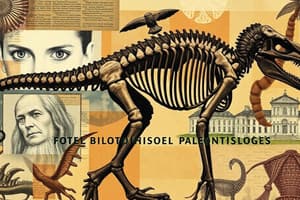Podcast
Questions and Answers
What is paleontology?
What is paleontology?
- The study of fossils, including their age, formation, and evolutionary significance (correct)
- The analysis of rocks and minerals
- The study of living organisms
- The process of fossilization
What is the age range of fossils?
What is the age range of fossils?
- Between 3.48 billion years old to 4.1 billion years old (correct)
- Over 10,000 years old
- Between 50 million years old to 100 million years old
- Less than 1,000 years old
What is the process of fossilization?
What is the process of fossilization?
- The process of preserving only hard parts of organisms
- The process of preserving soft tissues in sedimentary rock
- The process of turning organic matter into stone
- Permineralization, casts and molds, authigenic mineralization, replacement and recrystallization, adpression, carbonization, and bioimmuration (correct)
What are trace fossils?
What are trace fossils?
What are index fossils used for?
What are index fossils used for?
What are Lagerstätten?
What are Lagerstätten?
What is biostratigraphy?
What is biostratigraphy?
What is the primary NASA objective in searching for evidence of habitability, taphonomy, and organic carbon on Mars?
What is the primary NASA objective in searching for evidence of habitability, taphonomy, and organic carbon on Mars?
What is the practice of fossil trading?
What is the practice of fossil trading?
Flashcards
Fossils
Fossils
Preserved remains or traces of ancient organisms like bones, shells, and imprints.
Paleontology
Paleontology
The study of fossils, including their age, formation, and evolutionary significance.
Radiometric Dating
Radiometric Dating
The process of determining the absolute age of rocks and fossils using radioactive isotopes.
Index Fossils
Index Fossils
Signup and view all the flashcards
Trace Fossils (Ichnofossils)
Trace Fossils (Ichnofossils)
Signup and view all the flashcards
Fossil Record
Fossil Record
Signup and view all the flashcards
Lagerstätten
Lagerstätten
Signup and view all the flashcards
Fossilization
Fossilization
Signup and view all the flashcards
Stromatolites
Stromatolites
Signup and view all the flashcards
Study Notes
Fossils are preserved remains or traces of organisms from a past geological age, including bones, shells, stone imprints, and DNA remnants.
Paleontology is the study of fossils, including their age, formation, and evolutionary significance.
Fossils can be over 10,000 years old, with the oldest fossils being around 3.48 billion years old to 4.1 billion years old.
Radiometric dating techniques have allowed scientists to measure the absolute ages of rocks and fossils.
Fossilization processes include permineralization, casts and molds, authigenic mineralization, replacement and recrystallization, adpression, carbonization, and bioimmuration.
Fossils vary in size from one-micrometre bacteria to dinosaurs and trees weighing many tons.
Trace fossils or ichnofossils are marks left behind by the organism while it was alive, such as animal tracks or feces.
The fossil record is incomplete, but there is enough information available to give us a good understanding of the pattern of diversification of life on Earth.
Index fossils are used to define and identify geologic periods or faunal stages.
Microfossils are of critical importance as a reservoir of paleoclimate information.
Subfossils are remains, such as bones, nests, or fecal deposits, whose fossilization process is not complete, either because the length of time since the animal involved was living is too short or because the conditions in which the remains were buried were not optimal for fossilization.Summary Title: Fossils and their Study
-
Chemical fossils are chemicals found in rocks and fossil fuels that provide an organic signature for ancient life.
-
Radiometric dating is the only means of giving rocks greater than about 50 million years old an absolute age, and can be accurate to within 0.5% or better.
-
Stratigraphy is the science of deciphering the "layer-cake" that is the sedimentary record.
-
The fossil record is strongly biased toward organisms with hard-parts, leaving most groups of soft-bodied organisms with little to no role.
-
Fossil sites with exceptional preservation, sometimes including preserved soft tissues, are known as Lagerstätten.
-
Stromatolites are layered accretionary structures formed in shallow water by the trapping, binding and cementation of sedimentary grains by biofilms of microorganisms, especially cyanobacteria.
-
Pseudofossils are visual patterns in rocks that are produced by geologic processes rather than biologic processes.
-
Paleontologists examine the fossil record to understand the process of evolution and the way particular species have evolved.
-
Fossils have been visible and common throughout most of natural history, and so documented human interaction with them goes back as far as recorded history, or earlier.
-
Fossils appear to have directly contributed to the mythology of many civilizations, including the ancient Greeks.
-
In medieval China, the fossil bones of ancient mammals including Homo erectus were often mistaken for "dragon bones" and used as medicine and aphrodisiacs.
-
The search for evidence of habitability, taphonomy, and organic carbon on the planet Mars is now a primary NASA objective.The History and Significance of Fossils
-
Fossils have been observed and interpreted by humans for thousands of years, with early ideas of gradual climate change and the biblical deluge of Noah's Ark.
-
Fossils have been associated with mythology and folklore, such as the skulls of the Cyclopes and seashells as proof of Thor's protection.
-
Leonardo da Vinci and Robert Hooke were among the first to observe fossils as the petrified remains of ancient creatures, while William Smith observed that rocks of different ages preserved different assemblages of fossils.
-
Georges Cuvier became an active proponent of the geological school of thought called catastrophism, and Mary Anning's discoveries of fossils sparked both public and scholarly interest.
-
Darwin and his contemporaries linked the hierarchical structure of the tree of life with the then-sparse fossil record, and the fossil record has since been extended to between 2.3 and 3.5 billion years.
-
Paleontology has joined with evolutionary biology to share the interdisciplinary task of outlining the tree of life, and the fossil record and faunal succession form the basis of the science of biostratigraphy.
-
Absolute dating methods, such as radiometric dating, have been used to verify the relative ages obtained by fossils and to provide absolute ages for many fossils.
-
Recent research includes synchrotron X-ray tomographic analysis of early Cambrian bilaterian embryonic microfossils, which yielded new insights of metazoan evolution at its earliest stages.
-
Despite significant advances in uncovering and identifying paleontological specimens, it is generally accepted that the fossil record is vastly incomplete.
-
Fossil trading is the practice of buying and selling fossils, while fossil collecting is the collection of fossils for scientific study, hobby, or profit.
-
Fossils have also been used in traditional medicine as talismans and dinosaur bones have been used in Traditional Chinese medicine as "dragon bones."
-
The history and significance of fossils provide insight into the evolution of life on Earth and the development of science.
Studying That Suits You
Use AI to generate personalized quizzes and flashcards to suit your learning preferences.




